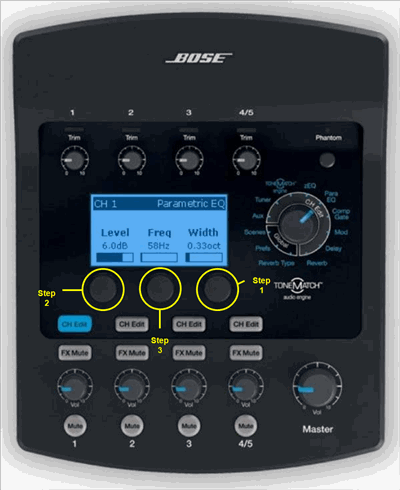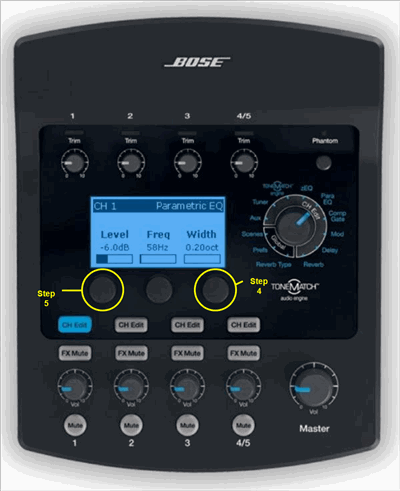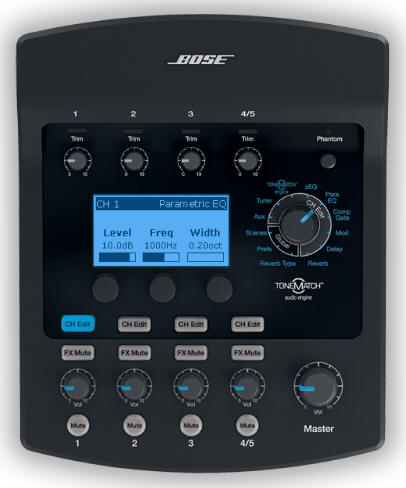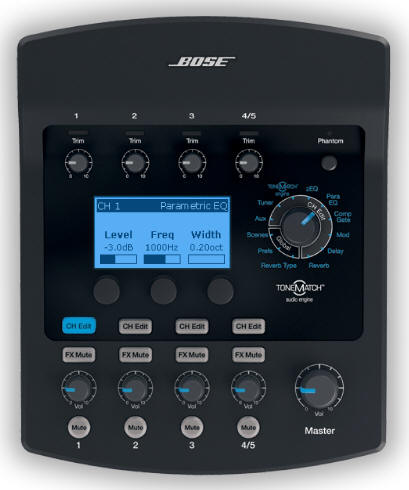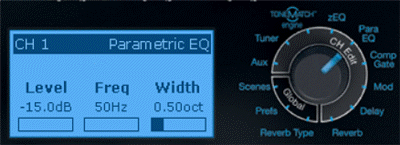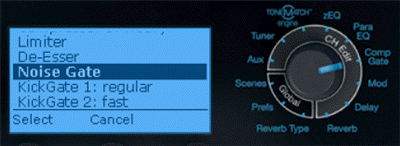Difference between revisions of "Parametric EQ / Solving Problems"
(first ed) |
m (ST moved page T1 ToneMatch® Audio Engine / Parametric EQ / Solving Problems to Parametric EQ / Solving Problems) |
||
| (27 intermediate revisions by 2 users not shown) | |||
| Line 1: | Line 1: | ||
| − | + | {{T4S icon}}{{T8S icon}}{{T1 icon}} | |
| + | {{DivToc | ||
| + | |RightHead = Introduction | ||
| + | |RightBody = You can use the Parametric EQ feature to notch out a problem frequency. Here are a few real-world examples. <br>This article applies to all ToneMatch mixers (T1/T4S/T8S). | ||
| − | == | + | |Categories = |
| − | + | [[Category:Para EQ]] | |
| + | [[Category:T1]] | ||
| + | [[Category:T4S]] | ||
| + | [[Category:T8S]] | ||
| + | }} | ||
| + | |||
| + | |||
| + | === Bassist With Excessive Resonance at B flat === | ||
| + | Chuck-at-Bose provided this approach.<ref>[http://bose.infopop.cc/eve/forums/a/tpc/f/7521050644/m/6531054674?r=1661015674#1661015674 Chuck-at-Bose talks about using the Para EQ to solve a problem frequency]</ref> | ||
| + | <table><tr><td valign="top"> | ||
| + | # Set the '''Width''' control to a value that's narrow enough to zoom in on the problem area, but wide enough to easily hear the effect of coarse adjustments. A value between one third (0.33) and one half (0.50) of an octave often works well as a starting point.<br /> | ||
| + | # Boost (turn up) the '''Level''' control a little, usually about +3 to +6 dB, so that coarse frequency adjustments (next step) can be easily heard.<br /> | ||
| + | # Rotate the '''Freq control''' to slowly sweep across the spectrum. Start low and sweep up until you hear the offending note jump out. Go back and forth until the problem note is centered, or at its loudest. For problem note, the frequency of the B flat note is approximately 58 Hz.<br> | ||
| + | </td> | ||
| + | <td> | ||
| + | [[Image:T1ParaEQCN01.png]] | ||
| + | </td> | ||
| + | </tr> | ||
| + | <tr> | ||
| + | <td valign="top"> | ||
| + | 4. Adjust the '''Width''' control to as narrow a value as possible, so that only the problem is being affected, leaving the non-offending frequencies around it unchanged. The T1 goes down to ''one fifth'' (0.20) of an octave, which is great for 'notching out' problem notes. <br /> | ||
| + | 5. Now adjust the '''Level'' control to cut (turn down) enough to make the problem go away, but not so much that the tone of the source is altered in an undesirable way. Values of -1 to -6 dB will often do the trick, though sometimes a more aggressive cut is necessary. Use your ears to find an appropriate balance between fixing the problem and adversely altering the tone of the source. | ||
| + | </td> | ||
| + | <td> | ||
| + | [[Image:T1ParaEQCN02.png]] | ||
| + | </td> | ||
| + | </tr> | ||
| + | </table> | ||
| + | |||
| + | === Another Approach to Eliminating a Boomy Note === | ||
| + | Hilmar-at-Bose had a different approach<ref>[http://bose.infopop.cc/eve/forums/a/tpc/f/7521050644/m/6531054674?r=7421005674#7421005674 Hilmar-at-Bose talks about solving a boomy note]</ref> | ||
| + | |||
| + | a) set the level of the para EQ to a cut, say -10 dB | ||
| + | |||
| + | b) set the width to fairly narrow, say .25 octaves | ||
| + | |||
| + | c) start with a rough estimate of the offending frequency and then move the frequency around until the offending note gets tamed best | ||
| + | |||
| + | d) you can press on the level control to toggle between on and off which gives you a direct A/B so you can judge the effect better | ||
| + | |||
| + | Once you have centered on the frequency you adjust the level and width to taste. | ||
| + | |||
| + | Estimating the frequency: | ||
| + | * Low octave of the bass is from 40 Hz to 80 Hz (E1 to E2), A1 is at 55 Hz | ||
| + | * Low octave on the guitar is from 80 Hz to 160 Hz (E2 to E3), A2 is at 110 Hz | ||
| + | * 2nd octave on the guitar is from 160 Hz to 320 Hz (E3 to E4), A3 is at 220 Hz | ||
| + | |||
| + | Here is a cheat sheet: [http://www.phy.mtu.edu/~suits/notefreqs.html Frequency vs. Musical Notes Graphic from MIT] | ||
| + | |||
| + | <noinclude> | ||
| + | === Controlling Vocal Microphone Feedback === | ||
| + | |||
| + | {{:Feedback / T1 ToneMatch® Audio Engine}} | ||
| + | |||
| + | </noinclude> | ||
| + | |||
| + | === Piezo Pickup Thump === | ||
| + | |||
| + | If you have an Acoustic Guitar that is picking up low end thump from a percussive right hand technique use the Para EQ with settings like this. | ||
| − | + | *Level -15 | |
| − | + | *Frequency 50 Hz | |
| − | + | *Width 0.50 | |
| − | + | [[Image:T1ParaEQNoThump.png]] | |
| − | |||
| − | === | + | [http://bose.infopop.cc/eve/forums?a=tpc&f=7521050644&m=6771047194&r=4591097194 T1 and x bridge] - Strat man |
| − | |||
| − | [[Image: | + | <br> |
| + | |||
| + | === Single Coil Buzz === | ||
| + | |||
| + | Use the Noise Gate | ||
| + | |||
| + | [[Image:T1NoiseGate01.png]] | ||
| + | |||
| + | <br> [[Image:T1NoiseGateDefault.png]] | ||
| + | |||
| + | The default settings seem to work okay for me. | ||
| + | |||
| + | [http://bose.infopop.cc/eve/forums?a=tpc&s=8206048934&f=7521050644&m=3771027294&r=1191035105#1191035105 eliminating single coil buzz] - jayare and ST | ||
| + | |||
| + | <br> | ||
| + | |||
| + | <br> | ||
| + | |||
| + | === Wind Noise === | ||
| + | :A microphone responds to the movement of air and it does not care what caused the air to move. This means that a mic cannot distinguish between air movement originating from a talker, and air movement originating from local weather. Wind noise is a persistent problem with microphones but there are multiple ways to minimize unwanted noise. | ||
| + | |||
| + | :Wind noise has a large amount of low frequency (bass) content, often described as “rumble.” Cutting out the extreme bass from a microphone signal is an effective method to reduce audible wind noise. | ||
| + | |||
| + | ---- Source: [http://blog.shure.com/shure-notes/shure-tech-tip-methods-to-minimize-wind-noise/ shure tech tips to minimize wind noise] | ||
| + | |||
| + | Use the ParaEQ (Woody B called it the notch filter) | ||
| + | |||
| + | :I had an extremely windy gig last night. Even with windscreens on the mics they still had the wind rumble. I used the notch filter on my T1 to notch the wind sound out. I don't believe it's called a notch filter on the T1, but I don't remember the correct name. I just turned the volume way up, and adjusted the frequency until the wind noise was gone. I tried using the noise gate, but if it was high enough to eliminate the wind it also eliminated most of the vocals. Usually wind screens solve any wind problems I have, but the wind was so strong I kept my guitar case on stage to sit my guitar in, instead of using a stand. I believe the wind would have blown it over. | ||
| − | = | + | [http://bose.infopop.cc/eve/forums/a/tpc/f/1266055944/m/6571097974?r=5021027294#5021027294 What to do in windy conditions] - Woody B |
| − | |||
| − | + | <br> | |
| − | |||
| − | |||
---- | ---- | ||
<references /> | <references /> | ||
| + | ---- | ||
| + | [[Category:Para EQ]] | ||
[[Category:T1]] | [[Category:T1]] | ||
| + | [[Category:T4S]] | ||
| + | [[Category:T8S]] | ||
Latest revision as of 14:34, 8 June 2021
Introduction
You can use the Parametric EQ feature to notch out a problem frequency. Here are a few real-world examples.
This article applies to all ToneMatch mixers (T1/T4S/T8S).
Bassist With Excessive Resonance at B flat
Chuck-at-Bose provided this approach.[1]
|
|
|
4. Adjust the Width control to as narrow a value as possible, so that only the problem is being affected, leaving the non-offending frequencies around it unchanged. The T1 goes down to one fifth (0.20) of an octave, which is great for 'notching out' problem notes. |
Another Approach to Eliminating a Boomy Note
Hilmar-at-Bose had a different approach[2]
a) set the level of the para EQ to a cut, say -10 dB
b) set the width to fairly narrow, say .25 octaves
c) start with a rough estimate of the offending frequency and then move the frequency around until the offending note gets tamed best
d) you can press on the level control to toggle between on and off which gives you a direct A/B so you can judge the effect better
Once you have centered on the frequency you adjust the level and width to taste.
Estimating the frequency:
- Low octave of the bass is from 40 Hz to 80 Hz (E1 to E2), A1 is at 55 Hz
- Low octave on the guitar is from 80 Hz to 160 Hz (E2 to E3), A2 is at 110 Hz
- 2nd octave on the guitar is from 160 Hz to 320 Hz (E3 to E4), A3 is at 220 Hz
Here is a cheat sheet: Frequency vs. Musical Notes Graphic from MIT
Controlling Vocal Microphone Feedback
The technique takes some practice and experimentation. But the effort is worth it because the technique can be used in many different situations.
You'll be using the parametric equalizer on the T1 ToneMatch Audio Engine to improve vocal microphone feedback. The parametric equalizer has a frequency adjustment to select the pitch (note) you want to shape, and a boost or cut adjustment to increase or decrease that pitch like a regular tone control. It also has a bandwidth knob, to set how wide a range of pitches around the single pitch you are adjusting.
- Turn the volume down on the microphone channel; mute any other microphone channels.
- Set the Para EQ Level to 10 dB boost (boost, not cut)
- Set the Para EQ Width to 0.20 oct
- Slowly turn up the volume of the microphone creating feedback to just before feedback. You'll probably start to hear the pitch that feeds back but don't let the feedback start.
- Start changing the Para EQ frequency control. At some point, the system will begin to feedback on the same pitch you were hearing without the boost. With some tuning and listening, you now have the Para EQ frequency set to the same (or very nearly the same) frequency causing feedback. You may need to change the volume of the microphone channel to avoid going into loud feedback.
- Change the ten dB boost to a cut, to notch out the frequency. Start with a cut of about 3 dB and use more only if necessary. That microphone should now be able to be used with less feedback.
If there are multiple microphones in the system you may find that the whole system feeds; if so, repeat this procedure for the other microphones (muting the other microphones while adjusting the Para EQ on one of them).
Once you know the frequency for one microphone (and the T1 tells you this in Hz), you can start by applying the same notch to other microphones -- but you may find that some adjustments are needed for each due to differences in the microphones and their different locations.
How much does this hurt the sound? You should experiment a little, since -- it depends. The notch will have different effects on the tone depending on how deep it is (how much you cut), how wide it is (keep it as narrow as you can), and where it is relative to your voice or instrument. Use your ears to tell you if you've gone too far.
This technique was described in a field report by Bill-at-Bose.
Here is a video about the relationship between the ToneMatch Presets, zEQ, ParaMetric EQ.
Piezo Pickup Thump
If you have an Acoustic Guitar that is picking up low end thump from a percussive right hand technique use the Para EQ with settings like this.
- Level -15
- Frequency 50 Hz
- Width 0.50
T1 and x bridge - Strat man
Single Coil Buzz
Use the Noise Gate
The default settings seem to work okay for me.
eliminating single coil buzz - jayare and ST
Wind Noise
- A microphone responds to the movement of air and it does not care what caused the air to move. This means that a mic cannot distinguish between air movement originating from a talker, and air movement originating from local weather. Wind noise is a persistent problem with microphones but there are multiple ways to minimize unwanted noise.
- Wind noise has a large amount of low frequency (bass) content, often described as “rumble.” Cutting out the extreme bass from a microphone signal is an effective method to reduce audible wind noise.
Source: shure tech tips to minimize wind noise
Use the ParaEQ (Woody B called it the notch filter)
- I had an extremely windy gig last night. Even with windscreens on the mics they still had the wind rumble. I used the notch filter on my T1 to notch the wind sound out. I don't believe it's called a notch filter on the T1, but I don't remember the correct name. I just turned the volume way up, and adjusted the frequency until the wind noise was gone. I tried using the noise gate, but if it was high enough to eliminate the wind it also eliminated most of the vocals. Usually wind screens solve any wind problems I have, but the wind was so strong I kept my guitar case on stage to sit my guitar in, instead of using a stand. I believe the wind would have blown it over.
What to do in windy conditions - Woody B

